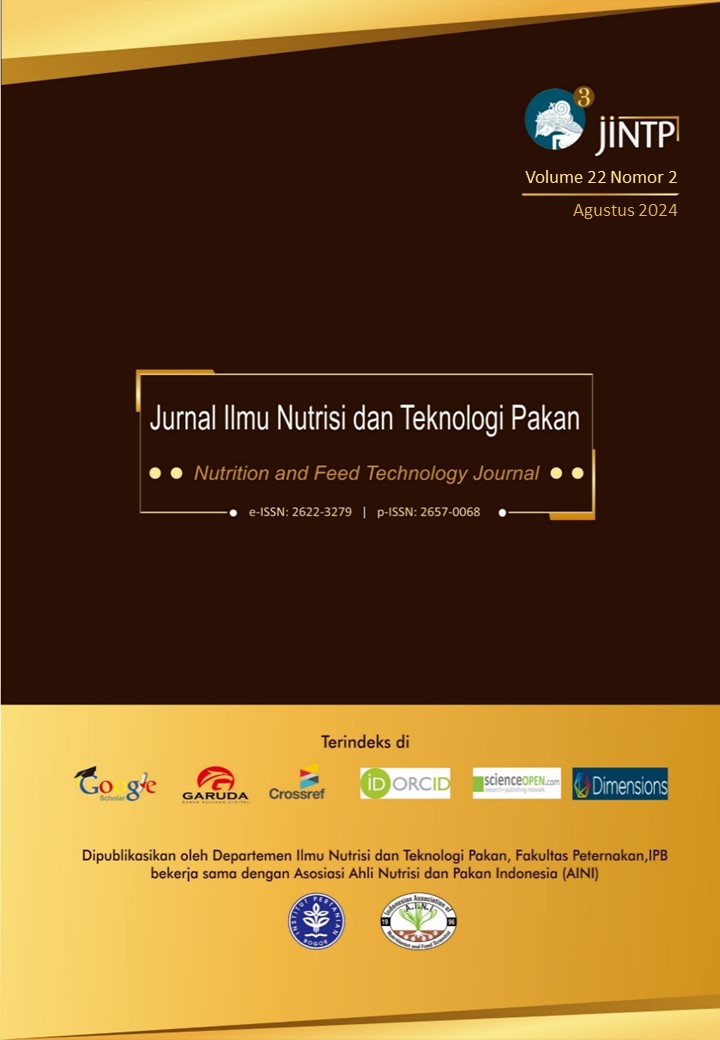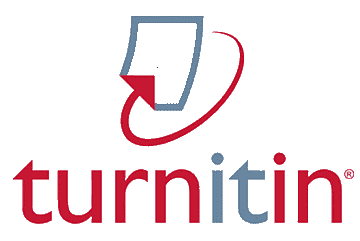Pemberian Tepung Bawang Dayak (Eleutherine palmifolia) dalam Pakan terhadap Profil Hematologi Darah Puyuh
The Effect of Feeding of Eleutherine palmifolia Meal in Diet on The Hematological Profile of Quail
Abstract
The study evaluated the effects of feeding Bawang Dayak (Eleutherine palmifolia) meal in the diet on the hematology profile in quails. A total of 160-layer quails (Coturnix-coturnix japonica strain) aged 8 weeks to 14 weeks were assigned on a completely randomized design (CRD) with 4 treatments, 4 replications with 10 quails per replication. The treatments consisted of R1 = diet control, R2 = diet contained 0.1% Bawang Dayak meal, R3 = diet contained 0.2% Bawang Dayak meal, and R4 = diet contained 0.3% Bawang Dayak meal. The variables observed were the hematology profile quail, including erythrocytes, hemoglobin, leukocytes, hematocrit, lymphocytes, heterophils, eosinophils, monocytes, basophils, and the ratio of heterophils to lymphocytes (H/L). Data were analyzed using analysis of variance (ANOVA), and any significant differences were tested using a post hoc Tukey test. The results showed that the usage of Bawang Dayak meal as a phytobiotic in the diet up to 0.3% did not affect quail blood hematology such as erythrocytes, hemoglobin, leukocytes, hematocrit, leukocyte differentiation and the ratio of H/L. The inclusion of 0.2% Bawang Dayak meal resulted in the H/L ratio being within normal conditions, reflecting its function to maintain stress levels of layer quails. In conclusion, utilization of Bawang Dayak meal in a diet of up to 0.3% does not affect the hematological profile of quail.
Key words: bawang dayak, Eleutherine palmifolia, hematology, quail
Downloads
References
Agina OA, Ezema WS, & Iwuoha EM. 2017. The haematology and serum biochemistry profile of adult japanese quail (Coturnix coturnix japonica). Notulae Scientia Biologicae. 9(1): 67-72.
Alagbe JO & Omokore EA. 2018. Growth and haematological parameters of Japanese quails (Corturnix cortuix japonica) fed dried Corn silk Polyalthia longifolia leaf meal mixture. Pacific International Journal. 1(3): 80-86.
Alagbe JO. 2024. Effect on performance, serum biochemistry and haematologicalcomponents of feeding “japanese quails” phytogenic feed additions comprising Megaphryniummacrostachyum leaves. Brazilian Journal of Science. 3(5): 51-64.
Anggraeni N, Farajallah A & Astuti DA. 2016. Blood profile of quails (Coturnix coturnix japonica) fed ration containing silkworm pupae (Bombyx mori) powder extract. Media Peternakan. 39(1): 1-8.
Ashari MS, Widodo E & Sudjarwo E. 2023. Pengaruh penambahan ekstrak daun ketepeng cina (Cassia alata L.) terhadap profil hematologi darah ayam pedaging. Majalah Ilmiah Peternakan. 26(2): 67-72.
Astuti DA, Maharani NE, Diapari D, Khotijah L & Komalasari K. 2020. Profil hematologi induk domba dengan pemberian pakan flusing berbeda. Jurnal Ilmu Nutrisi dan Teknologi Pakan. 20(2): 44-50.
Arifin B & Ibrahim S. 2018. Struktur, bioaktivitas dan antioksidan flavonoid. Jurnal Zarah. 6(1): 21-29.
Bahtiar MY, Yulianti DL & Krisnaningsih ATN. 2017. Pengaruh penggunaan tepung daun sambiloto (Andrographis paniculata nees) sebagai feed additive terhadap kualitas telur itik mojosari. Jurnal Sains Peternakan. 5(2): 92-99.
Direktorat Jendral Peternakan dan Kesehatan Hewan. 2022. Statistik Peternakan dan Kesehatan Hewan 2022. Jakarta (ID):Direktorat Jenderal Peternakan dan Kesehatan Hewan Kementerian Pertanian. ISSN : 2964-1047.
Edi DN, Natsir MH, & Djunaidi IH. 2020. Profil darah ayam petelur yang diberi pakan dengan penambahan fitobiotik esktrak daun jati (Tectona grandis Linn. f). Jurnal Peternakan. 17(2): 96-102.
Falahudin I, Pane ER, & Sugiati. 2016. Efektifitas larutan temulawak (Curcuma xanthorrhiza roxb.) terhadap peningkatan jumlah leukosit ayam broiler (Gallus gallus domestica sp.). Jurnal Biota. 2(1): 68-74.
Hardarani N& Dewi I. 2019. Kandungan antioksidan umbi bawang dayak di lahan gambut Landasan Ulin Utara pada umur panen yang berbeda. Prosiding Seminar Nasional Lingkungan Lahan Basah. 4(1), 174-179. Banjarmasin, Kalimantan Selatan (ID) : Lembaga Penelitian dan Pengabdian kepada Masyarakat, Universitas Lambung mangkurat,
Irawan A, Setiyatwan H, & Mayasari N. 2023. Gambaran jumlah eritrosit, kadar hemoglobin, dan nilai hematokrit puyuh padjadjaran yang diberi ekstrak biji ketumbar (Coriandrum sativum L.). Jurnal Nutrisi Ternak dan Ilmu Pakan. 5(1): 23-32.
Kalio GA, Wariboko ON & Okafor BB. 2016. Growth performance and haematological profile of growing japanese quails fed graded levels of Azadirachta indica leaf meal. Journal of Animal Science Advances. 6(2): 1586-1594.
Lestari LI, Kinanti AW, & Nita OAK. 2017. Pengaruh penambahan ekstrak kayu secang (Caesalpinia sappan l.) dan minyak ikan lemuru sebagai aditif pakan terhadap performa telur dan produktivitas puyuh. AVES: Jurnal Ilmu Peternakan. 12(1): 10-21
Mahbuba AM, Jabbar AAB, & Mustafa NA. 2022. The effectiveness of some medicinal plants on body performance, hematological, ileum morphology and immune statue of Japanese quail. Iraqi Journal of Agricultural Sciences. 53(4): 724-731.
Maheswari H, Sasmita AN, Farajallah A, Achmadi P, Santoso K. 2017. Pengaruh suhu terhadap diferensial leukosit serta kadar malondialdehide (mda) burung puyuh (Coturnix coturnix japonica). Bioma. 13(1): 81-89.
Munaeni W, Pariakan A, Yuhana M, Setiawan M & Abidin LOB. 2017. In vitro phytochemical and inhibitory potential tests of buton forest onion extract (Eleutherine palmifolia L. Merr.) on Vibrio harveyi. Microbiology Indonesia. 11(3): 75 - 80.
Napirah A, Supadmo & Zuprizal. 2013. Pengaruh penambahan tepung kunyit (Curcuma domestica Valet) dalam pakan terhadap parameter hematologi darah puyuh (Coturnix-coturnix japonica) pedaging. Buletin Peternakan. 37(2): 114-119.
Palupi R, Abdullah L, Astuti DA, & Sumiati. 2014. Potential and utilization of Indigofera sp. shoot leaf meal as soybean meal substitution in laying hen diets. Jurnal IlmuTernak dan Veteriner. 19(3): 210-219
Rahmawati H, Kismiati S, & Sarengat W. 2016. Efisiensi penggunaan protein pada puyuh periode produksi yang diberi ransum mengandung tepung daun Kayambang (Salvinia molesta). Jurnal Ilmu Ilmu Peternakan. 26(1): 1-6.
Santoso K, Harlimawan FB, Wijaya A, Isdoni, Maheshwari H, Ekastuti DR, Achmadi P, Tarigan R, Satyaningtijas AS, Suprayogi A & Manalu W. 2022. Profil leukosit burung puyuh yang mengalami cekaman panas setelah pemberian aspirin. Jurnal Peternakan Indonesia. 24(2): 180-189.
Sastradipradja D, Sikar SHS, Wijayakusuma R, Ungerer T, Maad A, Nasution H, Suriwinata R, & Hamzah R. 2000. Penuntun Praktikum Fisiologi Veteriner. [Pusat Antar] Bogor (ID): Universitas Ilmu Hayati.
Shoukary RDEL, Darwish MHA, & Abdel-Rahman MAM. 2015. Differential leucocyte count and total colony count changes in heat stress broiler. Journal of Advanced Veterinary Research. 5(1): 21-28.
Siegel HS. 1995. Stress, strain and resistance. British Poultry Science. 36(1): 3-22.
Sobingin A, Rinawidiastuti, & Iskandar F. 2019. Pengaruh pemberian sari jahe gajah (Zingiber officinale Rosc.) pada air minum terhadap profil darah puyuh (Coturnix coturnix japonica). Jurnal Riset Agribisnis & Peternakan. 4(1): 52-59.
Strakova E, Suchy P, Kabelova R, Vitula F & Herzig I. 2010. Values of selected haematological indikators in six species of feathered game. Acta Veterinaria Brno.79(9): 3-8.
Thomas KS, Jagatheesan PNR, Reetha TL & Rajendran D. 2016. Nutrient composition of Japanese Quail Eggs. International Journal of Science, Environment and Technology. 4(4): 1293-1295.
Tolik D, PolawskaE, Charuta A, Nowaczewski S & Cooper R. 2014. Characteristics of egg parts, chemical composition and nutritive value of japanese quail eggs – a review. Folia Biologica. 62(4): 287-292.
Uchendu CN, Obidike IR, Ochiogu IS, Aka LO& Anyaoha CO. 2010. Sex variations in the haematological profile of japanese quails (Coturnix coturnix) reared in a hot humid climate. Nigerian Journal of Experimental and Applied Biology. 11(2):19-226.
Ulupi N & Ihwantoro TT. 2014. Gambaran darah ayam kampung dan ayam petelur komersial pada kandang terbuka di daerah tropis. Jurnal Ilmu Produksi dan Teknologi Hasil Peternakan. 2(1):219–223.
Zakiyatulyaqin, Setiawan D & Purnomosidi M. 2020. The performance of broiler chickens with the addition of dayak onion extract in drinking water. Jurnal Ternak Universitas Islam Lamongan. 6(1): 91-96.
Zbikowski A, Pawlowski K, Slizewska K, Dolka B, Nerc J & SzeleszczukP. 2020. Comparative effects of using new multi-Strain Hematology, Serum Biochemistry and Immunity. Animals. 10(1555): 1–18.
Copyright (c) 2024 M Haerul, W Hermana, Sumiati

This work is licensed under a Creative Commons Attribution 4.0 International License.
The authors of the submitted manuscript have to understand and agree that the copyrights published are held by Jurnal Ilmu Nutrisi dan Teknologi Pakan. Copyrights includes rights in reproducing, distributing and selling every section of articles in all forms and media. The copyright transfer form is signed by the corresponding author. The author”
• Creative Commons Attribution (CC BY)
you are allowed to:
Share – copy and redistribute the material in any medium or format
Adapt – remix, transform, and build upon the material
for any purpose, even commercially.
The licensor cannot revoke these freedoms as long as you follow the license terms.
Jurnal Ilmu Nutrisi dan Teknologi Pakan (Nutrition and Feed Technology Journal)

This work is licensed under a Creative Commons Attribution 4.0 International License.












